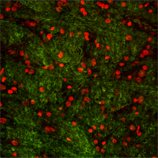Product Details
| Alternative Name: | AGTR1 |
| |
| Host: | Rabbit |
| |
| Immunogen: | Synthetic peptide corresponding to the sequence near the N-terminus of rat angiotensin II receptor AT1. |
| |
| UniProt ID: | P25095 (AT1A), P29089 (AT1B) |
| |
| Species reactivity: | Human, Mouse, Rat
|
| |
| Crossreactivity: | Predicted species reactivity based on epitope sequence homology: chimpanzee, bovine, rhesus macaque, sheep, dog, guinea pig, rabbit, horse, wild boar, gerbil. |
| |
| Applications: | ELISA, IHC, WB
|
| |
| Application Notes: | Suitable for cell-based and membrane-based ELISA.
Predicted MW of ~41kDa. Higher MW species (~55kDa) and intermediates also observed by Western blot which reflect post-translational modification and dimerization of the receptor. |
| |
| Purity Detail: | Peptide affinity purified. |
| |
| Formulation: | Liquid. In PBS containing 50% glycerol and 0.01% sodium azide. |
| |
| Handling: | Keep on ice at all times. |
| |
| Shipping: | Blue Ice |
| |
| Long Term Storage: | -20°C |
| |
| Scientific Background: | The actions of the octapeptide circulatory hormone angiotensin II are mediated by type one (AT1) and type two (AT2) angiotensin II receptors, members of the seven-transmembrane domain-containing GPCR family. AT1 expression is greatest in vascular smooth muscle, liver, kidney, adrenal cortex, brain, and lung, and is primarily responsible for the physiological effects of angiotensin II in cardiovascular homeostasis. The AT2 receptor displays approximately 30% identity to the AT1 receptor, and is highly expressed during embryonic development. AT2 expression in adult tissue is limited to the adrenal medulla, brain, and reproductive tissues, but is upregulated in injured tissue following myocardial infarction, vascular injury, and wound healing. |
| |
| Regulatory Status: | RUO - Research Use Only |
| |
| Manufacturer: | Manufactured by Proteimax. |
| |

Western blot analysis: MW marker (1) and 20µg of kidney membrane extract (2) probed with Angiotensin II Receptor (AT1) pAb at 3 µg/ml.

Immunohistochemistry analysis: Rat brain nucleus tractis solitarus fixed with 100% methanol and stained with propidium iodide (red) and Angiotensin II Receptor (AT1) pAb at 1:1000 (green).

Cellular ELISA: HEK293 cells expressing AT1 Receptor were treated with indicated concentrations of agonist (Angiotensin II) and probed with Angiotensin II Receptor (AT1) pAb (1:1000 of a stock solution of 1µg/μL) by ELISA. Data from vehicle treated cells were taken as 100%. Results are the mean ± SEM (n=3).

Membrane ELISA: Lewis rat kidney membranes (5 μg/well) were treated with 1 μM concentrations of agonist (Angiotensin II) and probed with Angiotensin II Receptor (AT1) pAb (1:250 to 1:2000 of a 1 μg/μL stock solution) by ELISA. Data from vehicle treated cells were taken as 100%. Results are the mean ± SEM (n=2).

Membrane ELISA: Lewis rat kidney membranes (5µg/well) were treated with indicated concentrations of agonist (Angiotensin II) and antagonist (Losartan) and probed with Angiotensin II Receptor (AT1) pAb (1:1000 of a stock solution of 1µg/μL) by ELISA. Data from vehicle treated cells were taken as 100%. Results are the mean ± SEM (n=3).
Please mouse over
Product Literature References
Generation of G protein-coupled receptor antibodies differentially sensitive to conformational states: A.S. Heimann, et al.; PloS One
12, e0187306 (2017),
Abstract;
Full Text
Immunohistochemical detection of angiotensin II receptors in mouse cerebellum and adrenal gland using "in vivo cryotechnique": Z. Huang, et al.; Histochem Cell Biol.
140, 477 (2013),
Abstract;
Related Products




















